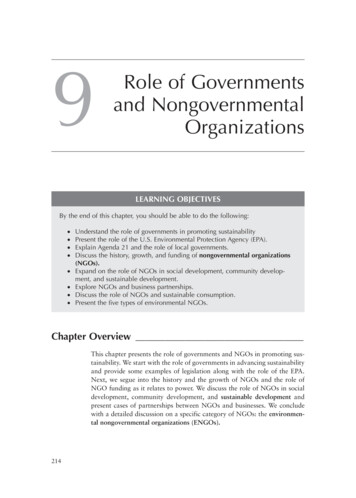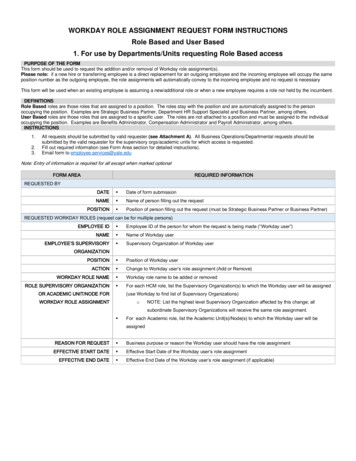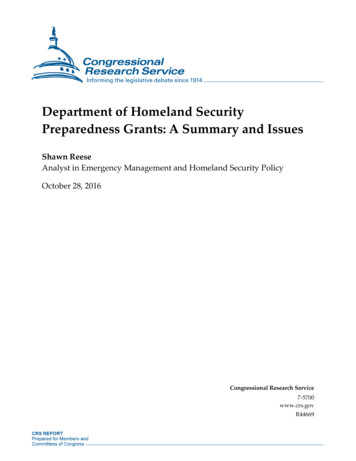
Transcription
9Role of Governmentsand NongovernmentalOrganizationsLEARNING OBJECTIVESBy the end of this chapter, you should be able to do the following: Understand the role of governments in promoting sustainabilityPresent the role of the U.S. Environmental Protection Agency (EPA).Explain Agenda 21 and the role of local governments.Discuss the history, growth, and funding of nongovernmental organizations(NGOs).Expand on the role of NGOs in social development, community development, and sustainable development.Explore NGOs and business partnerships.Discuss the role of NGOs and sustainable consumption.Present the five types of environmental NGOs.Chapter OverviewThis chapter presents the role of governments and NGOs in promoting sustainability. We start with the role of governments in advancing sustainabilityand provide some examples of legislation along with the role of the EPA.Next, we segue into the history and the growth of NGOs and the role ofNGO funding as it relates to power. We discuss the role of NGOs in socialdevelopment, community development, and sustainable development andpresent cases of partnerships between NGOs and businesses. We concludewith a detailed discussion on a specific category of NGOs: the environmental nongovernmental organizations (ENGOs).214
Chapter 9 Role of Governments and Nongovernmental Organizations215Role of GovernmentsWhat role, if any, should governments play in promoting sustainability?Governments worldwide are beginning to recognize the challenge of sustainability, and this term is being addressed in public policy discussions. Any onegovernment cannot work in this area alone; it is imperative to work withother governments in order to address the issue in a global context.According to a GlobeScan poll of experts, the leading role in achieving sustainability will be played by business (35%), followed by NGOs (30%), andgovernments (24%) (Bell, 2002). Chapter 8 discussed the role of business inadvancing sustainability, and this chapter will discuss the role of governments and NGOs in advancing sustainability.Governments need to be able to anticipate rising demand for sustainableproducts and services. Governments can play a key role in aiding the transition toward more efficient, less damaging economies. Those governmentsthat can lead in this role would be able to set the agenda for their economies,industries, and citizens (Peck & Gibson, 2002).In most developed countries, like the United States and Canada, the government is the largest employer, the largest landowner, and the largest fleetowner. The government is also the largest consumer of energy and has thelargest impact on the environment. It stands to reason that governmentsshould incorporate sustainability principles in their internal operations(Bell, 2002).In developing countries, the role of the government assumes even greatersignificance. Within the realm of sustainability, the governments ought toencourage companies to address the needs of the world’s entire population(Prahalad & Hart, 2002).According to a KPMG report, the government has four distinct roles inaddressing sustainability concerns. These roles are as follows:1. Policy development2. Regulation3. Facilitation4. Internal sustainability managementAs shown in Figure 9.1, each of the policy making, regulating, facilitating, and internal sustainability managing roles of government hasits own characteristics and success factors. Combined, these roles havethe potential to effectively support sustainability management throughsetting goals, driving change, and leading by example (“SustainableInsight,” 2009).
216PART III STAKEHOLDER INTEREST AND CHOICESFigure 9.1 Four Government Roles to Spur SustainabilityGOVERNMENT ROLES IN SUSTAINABILITYPOLICY DEVELOPMENTDevelopment of new policies to steer and enable sustainability innovationFACILITATIONCooperation with business, society and public sector in order to achieve sustainabilitypolicy objectivesCharacteristics Boundaries are set by recognition of major sustainability challenges atglobal, national, regional and/or local levels Used to prioritize, set goals and design coherent long-term strategies Formulate targets and determine type of government activities andbudgetCharacteristics Boundaries are set by political paradigms and ability and willingness of business and other actors to cooperate for change Used to stimulate breakthroughs in transition management R&D, endorsing, convening roles, financial incentives, societal cost benefitmanagementCriteria for success Focus on the most relevant and difficult issues from a long termperspective Define coherent and integrated strategies Formulate realistic goals (whose realization government is actually ableto influence)Criteria for success Align with other government sectors and agencies and with other roles inenhancing sustainability Set clear criteria for government initiative and the methods used in eachphase of transition Pull out whenever possible to create breakthroughs in new transitionsExamples 20% reduction in emissions, share of renewable energy use20% of total, overall cut of 20% in energy use by 2020 (EU) Millennium Development Goals (UN)REGULATIONAll government initiatives in legislation,administration and enforcementCharacteristics Boundaries set by (international) law Used to protect public benefit and to correct marketfailure in managing externalities Long term response to market (as it takes time to decideupon and implement new legislation)Examples Covenant of Mayors ( 400 EU Mayors) Green New Deal (USA)PolicyRegulationSet goalsFacilitationDrivechangeCSRLead byexampleSUSTAINABILITY MANAGEMENT WITHGOVERNMENT (CSR)The corporate social responsibility of each governmentbody as an economic actorCharacteristics Boundaries set by peer group, core values and stakeholders Used to lead by example and manage effects of core business Reduce carbon footprint, green procurement, managesupply chainCriteria for success Low administrative burden for government, business and consumers Sufficient (financial) incentives and controls to guarantee and enforcenew legislationCriteria for success Work principle based instead of rule based, use stakeholder dialogue andbe transparent Avoid ‘greenwashing’ Create sufficient leverage to have a real impact on core businessExamples Emission Trading Schemes of NO2 and CO2 (European Union and EUmember states) Regulation of supply chain management (e.g. REACH, WEEE, EuP,RoHS) Environmental Impact Assessment (e.g. CEQA, The CaliforniaEnvironmental Quality Act)Examples Governments will have to meet the goal of 100% green procurement in 2010(The Netherlands) European Green Capital (Stockholm 2010, Hamburg 2011) ‘Sustainable city’ pillar of Rotterdam Climate Initiative (The Netherlands)Source: Sustainable Insight (2009).Changing Role of GovernmentsIncreasingly, governments are called to form partnerships ranging from theones with other levels of government to ones with civil society organizations(CSOs) and the private sector. In terms of advancing sustainability, the government can also play a significant role. The five roles are discussed as follows:1. Vision/Goal setter: Governments need to provide vision and strategy toincorporate sustainability in public policy. Concepts such as naturalcapitalism (discussed in Chapter 6), eco-economy (Brown, 2009), andgreen economy (Milani, 2000) call for grand-scale transformations insystems dealing with energy, waste, water, and governance. Governmentswould need to develop strategies for a transition to an economy basedon sustainability principles.
Chapter 9 Role of Governments and Nongovernmental Organizations2. Leader by example: Governments can improve the environmentalperformance of public procurement (Organisation for EconomicCo-operation and Development [OECD], 2002), whereby publicfunds are used in construction of highways and buildings, powergeneration, transportation, and water and sanitation services. Greenprocurement can also provide impetus to innovative and environmentally friendly products. As an example, Japan used procurement oflow emission automobiles to drive innovation (Bell, 2002).3. Facilitator: Governments need to create “open, competitive, andrightly framed markets” that would include pricing of goods and services, dismantling subsidies, and taxing waste and pollution, etc.However, as Lester Brown (2002, p. 26) pointed out, “not one countryhas a strategy to build an eco-economy”.4. Green fiscal authority: Governments are exploring environmentaltaxes and market-based instruments for ecological fiscal reform.Though the market solutions can be more amenable to businesses fortheir flexibility, these approaches might not be the best at pricing certain environmental assets such as clean water (Bell, 2002).5. Innovator/Catalyst: The government needs to play a strategic role inadvancing innovation in all sectors of society since the advancementof sustainability will demand changes. There is a strong need for technological and policy innovation (Bell, 2002).The traditional role of a government is one of an authority figure that protects public interests and regulates industries. This role is changing as governments are working collaboratively with other stakeholders from companies toCSOs. As the roles of governments change, so do their responsibilities. Indeed,the whole future of a sustainable world can be shaped by the policy decisionstaken by governments, individually or in collective forums.Policy InstrumentsThere are two basic policy instruments that can be employed by governments:(1) direct regulation and (2) market instruments and economic/fiscal measures.Direct RegulationThe first form of public policy on environment was direct regulation. Theseapproaches are also termed as command and control approaches since thetaxes are set by the regulatory agency or the government, and the companiesneed to comply and pay these taxes. Though taxes are controversial and governments have faced pushback to the idea of carbon taxes, regulation is still aneffective mechanism to ensure minimum performance from those players thatare reluctant to comply.217
218PART III STAKEHOLDER INTEREST AND CHOICESMarket Instruments and Economic/Fiscal MeasuresThis category includes any set of instruments that reward innovation insustainability from the private sectors. These instruments can include subsidies, taxes, ecolabeling schemes, and public procurement policies. The idea isthat if the private sector is given enough motivation, the sector itself wouldcome up with the best way to solve a problem. One such example was thecap and trade system, wherein the cap on emissions would be set by theregulatory agency, and companies would have an incentive to lower emissions and trade the extra permits. Research does indicate that market mechanisms are efficient, flexible, and more palatable to industry (Dhanda, 1999).More detailed discussion on command and control versus market schemeswill be presented in Chapter 11.In addition, governments can also employ new policy instruments thatexpand the range of alternatives to regulation and legislation. The task ofchoosing the best “mix” from this wider array of possible options is notstraightforward (Howlett & Ramesh, 1995), and research is ongoing toassess these various alternatives. For example, Italy is experimenting with ascheme that provides the consumer with a modest (1%) sales tax reductionon the price of green products. France, on the other hand, has introducedmandatory corporate sustainability reporting (Bell, 2002).Role of the Environmental Protection AgencyIn the United States, the largest regulatory organization is the EPA, onethat from the time of its inception acted as a watchdog for the environmentimplementing pollution control regulations and ensured that businesses metthe legal requirements. As time progressed, the EPA’s role has changed frompollution control to pollution prevention. This change has led to implementation of some market-based regulation such as the Acid Rain and NOx capand-trade programs to reduce emissions. For the future, EPA is looking atadvances in science and technology and government regulations and promoting innovative green business practices (“What Is EPA Doing?” n.d.).Advances in Science and TechnologyThese advances in science and technology are important for robust environmental policy. The Office of Research and Development (ORD) at the EPAworks to develop long-term solutions. In addition, this office provides technical support to the EPA regional offices and to state and local governments.Government Regulations and PracticesExecutive orders are edicts that are issued by the president. Two executiveorders have been aimed at the environment:
Chapter 9 Role of Governments and Nongovernmental OrganizationsExecutive Order (EO) 13423 sets policy and goals for federal agencies to“conduct their environmental, transportation, and energy-related activitiesunder the law in support of their respective missions in an environmentally,economically and fiscally sound, integrated, continuously improving, efficient, and sustainable manner” (What Is EPA Doing?” n.d.).EO 13514 builds upon EO 13423 “to establish an integrated strategytowards sustainability in the Federal Government and to make reduction ofgreenhouse gas emissions (GHG) a priority for Federal agencies” (“What IsEPA Doing?” n.d.).The EPA also implements a range of programs to reduce the environmental impact of its operations. These can range from retrofitting old buildingsto the construction of newer, more energy efficient buildings. In addition, theSustainable Facilities Practices Branch publishes the annual reports on energymanagement and conservation programs.List of Environmental ProtectionAgency Programs for SustainabilityThere are numerous EPA policies and programs that have helped to shapenew ways of manufacturing and doing business (Hecht, 2009). Here are someexamples:Supply Chain and ManufacturingGreen Suppliers NetworkLean ManufacturingDesign for the EnvironmentClean ProcessingGreen Chemistry ProgramNanoscale Materials Stewardship ProgramManagement and PerformanceSector Strategies ProgramPerformance TrackPreferential PurchasingEnergyStarWaterSenseIn addition, the EPA provides resources for sustainable practices. Withinthe category of urban local sustainability, these programs range from smartgrowth and urban heat mitigation to waste composting and water resource219
220PART III STAKEHOLDER INTEREST AND CHOICESprograms. Within the category of industrial sustainability, the programsrange from green engineering and IT to ozone alternatives and safe pesticides(“Science and Technology: Sustainable Practices,” n.d.).These programs aim to shape practices that go beyond controlling pollution to actually changing the strategic thinking of companies. According tothe EPA, environmental protection will be created by a vision that inspiresbusinesses and consumers rather than by disincentives to pollute (“What IsEPA Doing?” n.d.).Local Governments for SustainabilityMuch of the work on sustainability has been accomplished at the locallevel. One of the most comprehensive programs is Agenda 21, which calls forinvolvement at the local, national, and global level. Agenda 21 articulates aseries of environmental strategies for the management of natural resources andthe monitoring and reduction of chemical and radioactive waste. It also contains socioeconomic plans to improve heath care, to develop sustainable farming development and fair trade policies, and to reduce poverty (Agenda 21,n.d.-b). Furthermore, Agenda 21 requires local governments to develop theirown “Local Agenda 21” for sustainable development. Agenda 21 is a largedocument with 40 chapters. The appendix to this chapter contains Chapter 27of Agenda 21, one that discusses the role of NGOs.Another local association is the International Council for LocalEnvironmental Initiatives (ICLEI)—Local Governments for Sustainability,comprised of over 1,200 local government members. The members of ICLEIrepresent 70 countries and more than 569,885,000 people (About ICLEI,n.d.). The programs and projects of ICLEI call for the following:participatory, long-term, strategic planning process that address localsustainability while protecting global common goods. Thisapproach links local action to internationally agreed-upon goals andtargets such as: Agenda 21, the Rio Conventions on Climate Change,Biodiversity, and Desertification, the Habitat Agenda, the MillenniumDevelopment Goal, and the Johannesburg Plan of Implementation.(“Our Themes,” n.d.)Nongovernmental OrganizationsDefinitionWhat is an NGO? The term NGO stands for nongovernmental organization, and it includes a variety of organizations such as “private voluntaryorganizations,” “civil society organizations,” and “nonprofit organization”
Chapter 9 Role of Governments and Nongovernmental Organizations(McGann & Johnstone, 2006). The term NGO describes a range of groupsand organizations from watchdog activist groups and aid agencies to development and policy organizations. Usually, NGOs are defined as organizations that pursue a public interest agenda, rather than commercial interests(Hall-Jones, 2006).It is believed that the first international NGO was probably the AntiSlavery Society, formed in 1839. However, the term NGO originated at theend of World War II when the United Nations sought to distinguish betweenprivate organizations and intergovernmental specialized agencies (Hall-Jones,2006). NGOs are a complex mixture comprised of alliances and rivalries;businesses and charities; conservatives and radicals. The funding comes fromvarious sources, and though NGOs are usually nonprofit organizations, thereare some that operate for profit (Hall-Jones, 2006).NGOs originate from all over the world and have access to differentlevels of resources. Some organizations focus on a single policy objective ofAIDS while others will aim at larger policy goals of poverty eradication(Hall-Jones, 2006).History of the Nongovernmental Organizations MovementThe first NGO was the Anti-Slavery Society followed by the Red Crossand Caritas, a movement that arose at the end of the 19th century. Most ofthe other NGO movements were founded after the two world wars and,hence, were primarily humanitarian in nature. For example, Save theChildren was formed after World War I, and CARE was formed after WorldWar II (Hall-Jones, 2006). The decolonization of Africa in the 1960s led to anew way of thinking—one that aimed at causes of poverty rather than itsconsequences. The armed conflicts of the 1970s and 1980s (Vietnam, Angola,Palestine) led the European NGOs to take on the task of mediators for informal diplomacy. Their support for locals had an impact on the demise of theapartheid regime in South Africa and the dictatorships of Ferdinand Marcosin the Philippines and Augusto Pinochet in Chile. In addition, in the mid1980s, the World Bank realized that NGOs were more effective and less corrupt than the typical government channels. The food crisis in Ethiopia in1984 spurred a new market for “humanitarian aid” (Berthoud, 2001).In the history of the NGO movement’s growth, there have been severalmilestones. One of the first milestones was the role of the solidarity movement in the political transformation in Poland in the 1980s. The next wasthe impact of environmental activists on the 1992 Earth Summit in Rio deJaneiro. Another milestone was the Fifty Years Is Enough campaign in 1994.This was organized by the South Council and was aimed at the World Bankand International Monetary Fund (IMF) on the belief that these two institutions had been promoting and financing unsustainable development overseas that created poverty and destroyed the environment. The most recent221
222PART III STAKEHOLDER INTEREST AND CHOICESmilestone was the organization of the labor, anti-globalization, and environmental groups that protested and disturbed the Seattle World TradeOrganization (WTO) meeting in 1999 (McGann & Johnstone, 2006).FundingThe numbers of NGO organizations have grown dramatically, and NGOshave become a powerful player in global politics, facilitated in part by theincreasing funding by public and private grants (McGann & Johnstone,2006). This funding comes in from all kind of sources and is redirected inevery conceivable direction. The world’s biggest NGO is the Bill & MelindaGates Foundation with an endowment of 28.8 billion. The 160 international nongovernmental organizations (INGOs) associated with InterActionhave combined annual revenues of 2.3 billion (Aall, 2000).There are some NGOs that are very sophisticated at wooing the mediawhile other unknown NGOs work tirelessly at the grassroots level. SomeNGOs are membership-based, such as Amnesty International, that refuse toaccept money from political parties, agencies, or governments whereas otherNGOs are profit-making organizations focused on lobbying for profit-driveninterests (Hall-Jones, 2006)One trend is that NGOs are becoming dependent on governments forfunding and service contracts. For example, 70% of CARE International’sbudget ( 420 million) came from government contributions in 2001, 25% ofOxfam’s income came from EU and British government in 1998, and 46% ofMédecins Sans Frontières (Doctors Without Borders) income came from government sources. Similarly, World Vision collected goods worth 55 millionfrom the U.S. government (Hall-Jones, 2006).Numbers and BudgetsINGOs rose in number from 6,000 in 1990 to 26,000 in 1996 (“The NonGovernmental Order,” 1999). At present, there are 1.5 million nonprofitorganizations in the United States and more than 1 million NGOs in India.Along with the growth in the number of NGOs, the memberships have alsobeen expanding at steady rate (“The Non-Governmental Order,” 1999).Some of the biggest NGOs in terms of size and financial strength are to befound in the humanitarian realm. For example, Oxfam, World Vision,CARE, and Save the Children are all strong brands that belong to extremelylarge organizations with strong financial power. The biggest NGO—WorldVision—had an annual budget of 2.1 billion for 2006 (Karajkov, 2007).Some of the other NGOs can boast of similar financial resources. Over70% of the relief funding goes to the biggest NGOs. The biggest eight arecomprised of the following organizations (Karajkov, 2007):
Chapter 9 Role of Governments and Nongovernmental Organizations1. World Vision, 2.1 billion (2006)2. Oxfam, 528 million (2004–2005)3. CARE, 624 million (2005)4. Save the Children, 863 million (2006)5. Catholic Relief Services, 694 million (2005)6. Doctors Without Borders, 568 million (2004)7. International Rescue Committee, 203 million (2005)8. Mercy Corps, 185 million (2005)Growth in PowerThe real story is how these organizations have networked and impactedworld politics.Global politics have gone through a drastic shift resulting from thegrowth of nongovernmental agencies. NGOs or CSOs have moved frombeing in the background to having a presence in the midst of world politicsand, as a result, are exerting their influence and power in policy making atglobal scale. Some organizations such as Amnesty International andGreenpeace have effectively become NGO brands and have helped makeNGO a household word. At the 1992 Earth Summit in Rio, there was alarge NGO presence. While 1,400 NGO members were involved in theofficial proceedings, another 17,000 NGO members staged an alternativeforum to the meeting. Encouraged by their success, a larger group gatheredin Beijing for the Fourth World Conference on Women (McGann &Johnstone, 2006).How have NGOs gained this global attention? There are various strategies that have been employed. For example, some NGOs organize largescale protests, capture international headlines, and gain notoriety. The twoNGOs that were successful in organizing large-scale action around specificthemes were Amnesty International, which focuses on human rights issues,and Greenpeace, which focuses on ecological issues (Berthoud, 2001).There are other NGOs that have organized meetings to challenge thelegitimacy of the WTO, the G8, the World Bank, and the IMF. The effectiveness of these NGOs’ efforts took the governments and other globalmultilateral institutions by surprise. In response, these efforts forced thegovernments to figure out ways to involve NGOs in their decision making.Now that their place in world politics is firmly established, the majority ofNGOs have moved from street protests to a policy making role in theboardrooms of the United Nations, WTO, World Bank, and the IMF(McGann & Johnstone, 2006).223
224PART III STAKEHOLDER INTEREST AND CHOICESWhat are the factors that have led to the unprecedented growth of NGOs?Research by McGann and Johnstone (2006) have isolated six interrelatedforces as follows:1. Democratization and the civil society ideal: The emergence of civilsociety and the addition of more open societies have both led to anenvironment that was favorable to the proliferation of NGOs.2. Growing demand for information, analysis, and action: The generalpublic is bombarded with unsystematic and unreliable information.NGOs can collect data to make decisions, a role that is invaluablein developing countries where such information might not readilyexist.3. Growth of state, nonstate, and interstate actors: After World War II,there was a global trend toward increased democratization and decentralization that led to an increase in the number of nations or statesafter World War II. In addition, numerous intergovernmental organizations (United Nations, WTO, World Bank) were created and weregranted certain powers and functions. This led to an unprecedentedgrowth in the number of governmental organizations, NGOs, andnation–states.4. Improved communications technologies: The growth of the Internethas led to inexpensive, instant, and largely unregulated flow of information. In addition, the nature of the information age makes it verydifficult to restrict the inflow of information from the perspective ofauthoritarian governments.5. Globalization of NGO funding: The issue of funding is importantsince many organizations work with small budgets and staffs. Inmany nations such as in Africa, Asia, and Latin America, there areno tax incentives to fund NGOs. Hence, most of the funding flowsfrom developed countries to developing or transitional countries.However, foreign funding raises questions about the credibility ofan organization. Furthermore, the issues of funding, transparency,and accountability become more complicated when NGOs crossnational borders.6. Paralysis and poor performance of the public sector: There has beenan erosion of confidence in the government leaders and institutions.The never-ending scandals involving public officials combined withpoor performance of policy makers have led citizens to question thelegitimacy of governments. When the institutions are considered ineffective and the nation–state is distrusted, the NGOs operating on alocal, grassroots level have emerged so that these deficiencies can beaddressed.
Chapter 9 Role of Governments and Nongovernmental Organizations225Role of Nongovernmental OrganizationsGiven this unprecedented growth in the numbers and financial power ofNGOs, how has the role changed or matured? What we see is that NGOscan have a huge impact. These NGOs are unfettered, not answerable tospecific agendas, and, in many instances, can act independently.Even though NGOs are highly diverse organizations, the one common goalis that they are not focused on short-term targets, and, hence, they devote themselves to long-term issues like climate change, malaria prevention, or humanrights. In addition, public surveys state that NGOs often have public trust,which makes them a useful proxy for societal concerns (Hall-Jones, 2006).Next, we will discuss four important roles of NGOs. These roles are(1) social development, (2) sustainable community development, (3) sustainable development, and (4) sustainable consumption.Social DevelopmentNGOs play an important role in global social development—work thathas helped facilitate achievements in human development as measured by theUN Human Development Index (HDI) (n.d.).One of the major strengths of NGOs is their ability to maintain institutional independence and political neutrality. Even though NGOs need to collaborate with governments in numerous instances, failure to maintainneutrality and autonomy may severely compromise the NGOs’ legitimacy.Unfortunately, if a government insists upon political allegiance, the NGOsencounter the dilemma of either violating the neutrality position or failing toprovide needed services to the population. Indeed, some NGOs have beenasked to leave in troubled countries due to political reasons (Asamoah, 2003).The major advantages that NGOs bring to this role include “flexibility,ability to innovate, grass-roots orientation, humanitarian versus commercialgoal orientation, non-profit status, dedication and commitment, and recruitment philosophy” (Asamoah, 2003). The drawbacks in working with NGOsare similar to the advantages that were previously listed. In addition, someother disadvantages include “over-zealousness, restricted local participation,inadequate feasibility studies, conflicts or misunderstandings with host partner, inflexibility in recruitment and procedures, turf wars, inadequatelytrained personnel, lack of funding to complete projects, lack of transparency,inability to replicate results, and cultural insensitivity” (Asamoah, 2003).Sustainable Community DevelopmentNGOs have shown leadership in promoting sustainable community development. Due to their particular ideology and nature, NGOs are good at
226PART III STAKEHOLDER INTEREST AND CHOICESreaching out to the poor and remote communities and mobilizing thesepopula
Vision/Goal setter: Governments need to provide vision and strategy to incorporate sustainability in public policy. Concepts such as natural capitalism (discussed in Chapter 6), eco-economy (Brown, 2009), and green economy (Milani, 2000) call for grand-scale transformations in systems dealing with energy, waste, water, and governance. Governments










